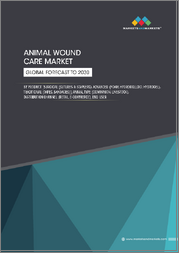
|
시장보고서
상품코드
1593538
만성 창상관리 시장 규모, 점유율, 성장 분석(제품별, 용도별, 지역별) : 산업 예측(2024-2031년)Chronic Wound Care Market Size, Share, Growth Analysis, By Product (Advanced Wound Dressing, Foam Dressing), By Application (Diabetic Foot Ulcers), By Region - Industry Forecast 2024-2031 |
||||||
세계의 만성 창상관리 시장 규모는 2022년에 213억 6,000만 달러로 평가되며, 2023년 222억 5,000만 달러에서 2031년에는 308억 5,000만 달러로 확대하며, 예측 기간(2024-2031년)에 4.17%의 CAGR로 성장할 전망입니다.
만성창상 시장은 당뇨병, 암, 자가면역질환 등 만성질환의 유병률 증가, 항균제 내성으로 인한 건강 문제 증가, 좌식생활, 흡연, 음주 등 생활습관 요인으로 인해 큰 성장이 예상되고 있습니다. 세계상시술료학회(WHS)는 당뇨병성 궤양, 욕창, 동맥성 궤양을 만성 상처의 주요 범주로 분류하고 있으며, 전문적인 의료 개입과 만성 상처 관리 제품이 필요한 것으로 보고 있습니다. 예를 들어 미국 인구의 약 10.5%에 해당하는 약 3,420만 명이 당뇨병을 앓고 있으며, 효과적인 상처 관리 솔루션에 대한 필요성이 증가하고 있으며, CDC의 2020년 전국 당뇨병 통계 보고서에서 강조한 바와 같이, COVID-19 팬데믹의 영향으로 의료용 피복재, 진단 및 의료용 커버링, 진단 용품 및 각종 의료 제품에 대한 인식과 요구가 높아져 시장 수요가 더욱 활성화되고 있습니다. 이러한 소비자 행동의 변화는 시장 모멘텀을 유지하고 상처 관리 제품에 대한 일관된 수요를 촉진할 것으로 보입니다. 또한 위생과 청결에 대한 소비자의 인식이 눈에 띄게 높아지면서 멸균 제품, 의류, 손 소독제에 대한 수요가 증가할 것으로 예상됩니다. 전반적으로 만성질환의 유행, 전염병으로 인한 의료 수요 증가, 위생에 대한 관심 증가는 향후 수년간 만성 상처 시장과 그 제품 제공을 형성하는 주요 요인입니다.
목차
서론
- 분석 목적
- 정의
- 시장 범위
분석 방법
- 정보 조달
- 2차 데이터 소스와 1차 데이터 소스
- 시장 규모 예측
- 시장의 상정과 제한
개요
- 시장 개요와 전망
- 수급 동향 분석
- 부문별 기회 분석
시장 역학과 전망
- 시장 개요
- 시장 규모
- 시장 역학
- 촉진요인과 기회
- 억제요인과 과제
- Porter의 산업 분석과 영향
- 경쟁 기업 간 경쟁 관계
- 대체품의 위협
- 바이어의 교섭력
- 신규 진출업체의 위협
- 공급 기업의 교섭력
주요 시장 인사이트
- 주요 성공 요인
- 경쟁의 정도
- 주요 투자 기회
- 시장 에코시스템
- 기술 진보
- 규제 상황
- 특허 분석
- 밸류체인 분석
- 사례 연구 분석
- PESTEL 분석
- 거시경제 지표
- 공급망 분석
세계의 만성 창상관리 시장 규모(제품별)·CAGR(2024-2031년)
- 시장 개요
- 첨단 창상 피복재
- 폼 피복재, 하이드로콜로이드 피복재
- 필름 피복재
- 알긴산 피복재
- 하이드로겔 피복재
- 콜라겐 피복재
- 기타 피복재
- 외과적 창상관리
- 봉합사·스테이플
- 조직 접착제·실란트
세계의 만성 창상관리 시장 규모(용도별)·CAGR(2024-2031년)
- 시장 개요
- 당뇨병성 족궤양
- 욕창
- 정맥성 하지 궤양
- 기타
세계의 만성 창상관리 시장 규모(최종사용자별)·CAGR(2024-2031년)
- 시장 개요
- 병원
- 전문 클리닉
- 재택 의료
- 기타
세계의 만성 창상관리 시장 규모·CAGR(2024-2031년)
- 북미(제품별, 용도별, 최종사용자별)
- 미국
- 캐나다
- 유럽(제품별, 용도별, 최종사용자별)
- 영국
- 독일
- 스페인
- 프랑스
- 이탈리아
- 기타 유럽
- 아시아태평양(제품별, 용도별, 최종사용자별)
- 중국
- 인도
- 일본
- 한국
- 기타 아시아태평양
- 라틴아메리카(제품별, 용도별, 최종사용자별)
- 브라질
- 기타 라틴아메리카
- 중동 및 아프리카(제품별, 용도별, 최종사용자별)
- 걸프협력회의(GCC) 국가
- 남아프리카공화국
- 기타 중동 및 아프리카
경쟁 정보
- 상위 5사의 비교
- 주요 기업의 시장 포지셔닝(2023년)
- 주요 시장 기업이 채택한 전략
- 시장의 최근 동향
- 기업의 시장 점유율 분석(2023년)
- 주요 기업의 기업 개요
- 회사 개요
- 제품 포트폴리오 분석
- 부문별 점유율 분석
- 매출의 전년대비 성장률(YoY) 비교(2021-2023년)
주요 기업 개요
- JOHNSON & JOHNSON
- BAXTER INTERNATIONAL
- Coloplast Corp.
- 3M
- Medline Industries, Inc.
- ConvaTec Group PLC
- Derma Sciences(Integra LifeSciences)
- Molnlycke Health Care AB
- Paul Hartmann AG
- Smith & Nephew PLC
- Molnlycke Health Care AB
- Tissue Regenix
- B. Braun Melsungen AG
- Integra LifeSciences Corporation
- Cardinal Health
- MiMedx
결론과 권장사항
KSA 24.12.02Global Chronic Wound Care Market size was valued at USD 21.36 Billion in 2022 and is poised to grow from USD 22.25 Billion in 2023 to USD 30.85 Billion by 2031, growing at a CAGR of 4.17% in the forecast period (2024-2031).
The chronic wounds market is poised for significant growth, driven by an increasing incidence of chronic diseases such as diabetes, cancer, and autoimmune disorders, alongside rising health concerns from antimicrobial resistance and lifestyle factors like sedentary behavior, tobacco, and alcohol use. The Wound Healing Society (WHS) identifies diabetic ulcers, pressure ulcers, and arterial ulcers as the primary categories of chronic wounds, necessitating specialized medical interventions and chronic wound care products. For instance, as highlighted by the CDC's 2020 National Diabetes Statistics Report, approximately 34.2 million individuals, representing about 10.5% of the U.S. population, are affected by diabetes, intensifying the need for effective wound management solutions. The impact of the COVID-19 pandemic has further catalyzed market demand, as it has heightened awareness and requirement for medical dressings, diagnostic supplies, and various healthcare products. This shift in consumer behavior is likely to sustain market momentum, driving a consistent need for wound care products. Additionally, there is a noticeable increase in consumer awareness regarding hygiene and sanitation, projecting an uplift in demand for sterilization products, clothing, and hand sanitizers. Overall, the convergence of chronic disease prevalence, heightened healthcare demands from the pandemic, and a growing focus on hygiene are key factors that will shape the chronic wounds market and its product offerings in the coming years.
Top-down and bottom-up approaches were used to estimate and validate the size of the Global Chronic Wound Care market and to estimate the size of various other dependent submarkets. The research methodology used to estimate the market size includes the following details: The key players in the market were identified through secondary research, and their market shares in the respective regions were determined through primary and secondary research. This entire procedure includes the study of the annual and financial reports of the top market players and extensive interviews for key insights from industry leaders such as CEOs, VPs, directors, and marketing executives. All percentage shares split, and breakdowns were determined using secondary sources and verified through Primary sources. All possible parameters that affect the markets covered in this research study have been accounted for, viewed in extensive detail, verified through primary research, and analyzed to get the final quantitative and qualitative data.
Global Chronic Wound Care Market Segmental Analysis
Global Chronic Wound Care Market is segmented by Product, application, end user and region. Based on Product, the market is segmented into Advanced Wound Dressing, Foam Dressing, Hydrocolloid Dressing, Film Dressing, Alginate Dressing, Hydrogel Dressing, Collagen Dressing, Other Dressing, Surgical Wound Care, Suture & Staples, and Tissue Adhesive & Sealants. Based on Application, the market is segmented into Diabetic Foot Ulcers, Pressure Ulcers, Venous Leg Ulcers, Others. Based on end user, the market is segmented into Hospitals, Specialty Clinics, Home Healthcare, Others. Based on region, the market is segmented into North America, Europe, Asia Pacific, Latin America and Middle East & and Africa.
Driver of the Global Chronic Wound Care Market
The increasing elderly population is a significant market driver for the Global Chronic Wound Care market, as this demographic is more vulnerable to chronic conditions like diabetes, arthritis, and impaired mobility, which often lead to complications such as pressure ulcers and diabetic foot ulcers. The prevalence of these chronic diseases among older adults necessitates ongoing and specialized wound management, thereby accelerating the demand for advanced wound care products. This trend not only highlights the urgent need for effective treatment solutions but also presents lucrative opportunities for innovation and advancements in wound care technologies that cater specifically to the aging population's healthcare needs.
Restraints in the Global Chronic Wound Care Market
The Global Chronic Wound Care market faces significant restraints due to the high costs associated with advanced wound care technologies. Innovations such as growth factor dressings and specialized devices, while enhancing patient outcomes, are financially burdensome, particularly in developing regions where healthcare budgets are limited. These soaring expenses restrict access to essential treatments, compelling healthcare systems to favor more traditional and less effective wound care options. This scenario not only undermines the potential benefits of advanced technologies but also exacerbates the disparities in wound care quality globally, ultimately hindering market growth and innovation in underserved areas.
Market Trends of the Global Chronic Wound Care Market
The Global Chronic Wound Care market is experiencing a significant shift towards the increasing adoption of telemedicine and remote wound care solutions. This trend reflects a growing reliance on digital health technologies that facilitate real-time monitoring and assessment of wound healing processes from the comfort of patients' homes. Telemedicine enables healthcare professionals to provide effective, timely interventions, particularly for patients in rural or underserved areas, thereby reducing the need for frequent hospital visits. As patient demand for convenience and accessibility rises, this trend is expected to drive the market growth, fostering innovative solutions that enhance patient outcomes and streamline healthcare delivery.
Table of Contents
Introduction
- Objectives of the Study
- Scope of the Report
- Definitions
Research Methodology
- Information Procurement
- Secondary & Primary Data Methods
- Market Size Estimation
- Market Assumptions & Limitations
Executive Summary
- Global Market Outlook
- Supply & Demand Trend Analysis
- Segmental Opportunity Analysis
Market Dynamics & Outlook
- Market Overview
- Market Size
- Market Dynamics
- Driver & Opportunities
- Restraints & Challenges
- Porters Analysis & Impact
- Competitive rivalry
- Threat of substitute
- Bargaining power of buyers
- Threat of new entrants
- Bargaining power of suppliers
Key Market Insights
- Key Success Factors
- Degree of Competition
- Top Investment Pockets
- Market Ecosystem
- Technological Advancement
- Regulatory Landscape
- Patent Analysis
- Value Chain Analysis
- Case Study Analysis
- PESTEL Analysis
- Macro-Economic Indicators
- Supply Chain Analysis
Global Chronic Wound Care Market Size by Product & CAGR (2024-2031)
- Market Overview
- Advanced Wound Dressing
- Foam Dressing, Hydrocolloid Dressing
- Film Dressing
- Alginate Dressing
- Hydrogel Dressing
- Collagen Dressing
- Other Dressing
- Surgical Wound Care
- Suture & Staples
- Tissue Adhesive & Sealants
Global Chronic Wound Care Market Size by Application & CAGR (2024-2031)
- Market Overview
- Diabetic Foot Ulcers
- Pressure Ulcers
- Venous Leg Ulcers
- Others
Global Chronic Wound Care Market Size by End-user & CAGR (2024-2031)
- Market Overview
- Hospitals
- Specialty Clinics
- Home Healthcare
- Others
Global Chronic Wound Care Market Size & CAGR (2024-2031)
- North America, (Product, Application, End-user)
- US
- Canada
- Europe, (Product, Application, End-user)
- UK
- Germany
- Spain
- France
- Italy
- Rest of Europe
- Asia-Pacific, (Product, Application, End-user)
- China
- India
- Japan
- South Korea
- Rest of Asia Pacific
- Latin America, (Product, Application, End-user)
- Brazil
- Rest of Latin America
- Middle East & Africa, (Product, Application, End-user)
- GCC Countries
- South Africa
- Rest of Middle East & Africa
Competitive Intelligence
- Top 5 Player Comparison
- Market Positioning of Key Players, 2023
- Strategies Adopted by Key Market Players
- Recent Developments in the Market
- Company Market Share Analysis, 2023
- Company Profiles of All Key Players
- Company Details
- Product Portfolio Analysis
- Company's Segmental Share Analysis
- Revenue Y-O-Y Comparison (2021-2023)
Key Company Profiles
- JOHNSON & JOHNSON
- Company Overview
- Business Segment Overview
- Financial Updates
- Key Developments
- BAXTER INTERNATIONAL
- Company Overview
- Business Segment Overview
- Financial Updates
- Key Developments
- Coloplast Corp.
- Company Overview
- Business Segment Overview
- Financial Updates
- Key Developments
- 3M
- Company Overview
- Business Segment Overview
- Financial Updates
- Key Developments
- Medline Industries, Inc.
- Company Overview
- Business Segment Overview
- Financial Updates
- Key Developments
- ConvaTec Group PLC
- Company Overview
- Business Segment Overview
- Financial Updates
- Key Developments
- Derma Sciences (Integra LifeSciences)
- Company Overview
- Business Segment Overview
- Financial Updates
- Key Developments
- Molnlycke Health Care AB
- Company Overview
- Business Segment Overview
- Financial Updates
- Key Developments
- Paul Hartmann AG
- Company Overview
- Business Segment Overview
- Financial Updates
- Key Developments
- Smith & Nephew PLC
- Company Overview
- Business Segment Overview
- Financial Updates
- Key Developments
- Molnlycke Health Care AB
- Company Overview
- Business Segment Overview
- Financial Updates
- Key Developments
- Tissue Regenix
- Company Overview
- Business Segment Overview
- Financial Updates
- Key Developments
- B. Braun Melsungen AG
- Company Overview
- Business Segment Overview
- Financial Updates
- Key Developments
- Integra LifeSciences Corporation
- Company Overview
- Business Segment Overview
- Financial Updates
- Key Developments
- Cardinal Health
- Company Overview
- Business Segment Overview
- Financial Updates
- Key Developments
- MiMedx
- Company Overview
- Business Segment Overview
- Financial Updates
- Key Developments



















